Apple AirPods Trademark Update Hints At Exciting Future Features
 Credit: Bless This Stuff
Credit: Bless This Stuff
Toggle Dark Mode
While both of Apple’s 2018 fall product events came and went without so much as a mention about the company’s truly wireless AirPods update, we know with near certainty (based on a litany of patents, reports and corroborations) that Cupertino is currently at an advanced stage of developing AirPods 2.
This much has essentially been confirmed by earlier patents and reports, which Bloomberg’s Mark Gurman corroborated in a report published earlier this year. In it, he cited supply-chain sources who suggested Apple’s next-generation AirPods 2 would feature an array of built-in “wellness sensors” — such as for monitoring heart rate, VO2 levels, pulse and more.
Now, according to trademark filings submitted this week in Europe and Hong Kong, Apple appears to have gone ahead and updated its AirPods trademark classifications to include these very advancements and much more.
As Patently Apple notes, the company’s original AirPods registered trademark was issued on August 22, 2017 (just weeks ahead of being unveiled alongside the iPhone 7 and 7 Plus). The initial filing, however, only covered functions and concepts outlined under international Class 9, including audio-centric concepts like “components and accessories” capable of sound recording and reproducing via “speakers, earphones, headphones, microphones, voice control, radio transmitters, or other apparatus.”
Re-Classification
Apple’s new AirPods trademark filings in Europe and Hong Kong, meanwhile, “greatly expand coverage” to incorporate a plethora of possible new uses, features and functions as covered under the international trademark Class 10, 14 and 28, including features falling into the categories as outlined below:
“General Wellness Instruments” (Class 10), which covers things like “health, fitness, exercise, and wellness sensors, monitors, speakers and displays for measuring, displaying, tracking, reporting, monitoring, storing, and transmitting biometric data, heart rate, body movement, calories burned or other data” — or, as a “medical apparatus and instrument,” such as a thermometer, pulse meter or spirometer for the purpose of medical analysis.
“Horological and chronometric instruments” (Class 14), which includes things like “watches, clocks, or timepieces,” including chronographs, chronometers and other “horological and chronometric instruments” such as watch parts and accessories.
“Games and Playthings” (Class 28), which is a broad category covering everything from “electronic hand-held game units,” to computer games, video games and other “electronic amusement apparatus.”
Piecing It All Together
While it’s unclear how the concepts and devices covered under Class 28 would in any way play into a second-generation AirPods update, it’s definitely worth pointing out (as far as Class 14 is pertinent) that future AirPods could potentially [in some way or another] work in synergy with Apple Watch.
While we’ll obviously have to wait until further notice to confirm, at least some of the health and wellness sensors mentioned under Class 10 — namely, the heart rate, pulse and O2 monitors — are already among the most anticipated feature improvements of AirPods 2.
The only question, at this point, is when they’ll ultimately hit store shelves… And while we can’t answer that fully and accurately right now, estimates would that suggest AirPods 2 are literally right around the corner.
[The information provided in this article has NOT been confirmed by Apple and may be speculation. Provided details may not be factual. Take all rumors, tech or otherwise, with a grain of salt.]






